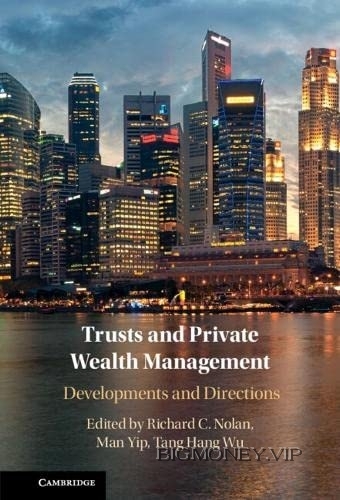
1
Introduction
Richard C. Nolan, Tang Hang Wu, and Man Yip
This book results from a conference, held in Singapore in August 2019, which we
organised to discuss the implications for trust law and wealth management of a topic
much discussed in other contexts, but less so in the present context: the enormous
and continuing rise of Asian wealth. The world economy has changed and continues
to change in focus to a degree not seen since the rise of European maritime powers,
beginning in the late fifteenth century. This change is compounded by the accel-
erating pace of technological change. The law – including trust law and the law of
wealth management – must acknowledge and accommodate these developments
and their consequences. We hope this volume is a contribution to that process.
Our book begins with an overview on ‘Family Trusts Today’ by Lady Arden
(Chapter 2). This chapter provides an insightful tour d’horizon of the problems that are
encountered in modern trust law practice. The chapter focuses on four problems that
affect modern family trust practice: privacy in family trust litigation, over-dominant
settlors and the doctrine of sham trusts, trustees’ liability to trust creditors in the event
of insolvency, and climate change and the handling of disputes between beneficiaries
and trustees. Lady Arden’s incisive treatment of the problems highlights the complexity
of modern trust practice and provokes us to consider more deeply the fundamental
tenets of the trust institution in order to work towards solutions.
On privacy in court proceedings, litigation concerning family trusts is not, by
default, heard in private. The court needs to balance between the private interest
of protecting beneficiaries’ identities (especially the identity of any vulnerable ben-
eficiaries) and the public interests of open justice and transparency. It is interesting
to note that some jurisdictions are now offering court-based resolution of disputes
in private, but only in the context of ‘non-local’ disputes, where the public inter-
est in transparency may be less than in a fully domestic context. The Singapore
International Commercial Court (which, notwithstanding its name, has jurisdic-
tion to hear trust disputes with an ‘international’ and ‘commercial’ character) is one
such example. Beyond the litigation context, developments such as trust registration
and data protection also enable greater transparency in private trusts but possibly at
the cost of a loss of privacy.
As to an over-dominant settlor and the sham trust doctrine, Lady Arden’s analysis
of the landmark decision of JSC Mezhdunarodniy Promyshlenniy Bank v. Pugachev
raises the profound question as to the proper basis on which to invalidate a trust,
even where it satisfies the usual certainty and formality requirements and does not
infringe the concept of irreducible core of trustee obligations.
Turning to the trustees’ liability to trust creditors in the event of insolvency, the
discussion exposes the potential unfairness arising from the unitary nature of the
legal personality of the trustee in cases where the trustee has incurred liability on
behalf of the trust. Without distinguishing between his or her personal and fidu-
ciary capacities, the trustee’s personal assets are put at risk to meet the trust liabili-
ties. The trustee may protect himself or herself through an appropriate contractual
limitation clause. Alternatively, the law may consider introducing statutory limita-
tion on trustee liability, such as Article 32 of the Jersey Trusts Law.
Finally, as climate change and sustainability developments have become global
concerns, the beneficiaries may disagree as to how trustees, generally guided by the
Cowan v. Scargill principle of maximising financial returns in the absence of explicit
direction in the trust deed, should exercise their powers of investment. Unlike the
corporate context, where corporate social responsibility is a recognised pillar of cor-
porate governance, it is more difficult to argue that investment in the family trust
context should be guided by a sustainability strategy.
Lady Arden suggests that on
encountering such a disagreement with the beneficiaries, even though there is no
obligation on the part of the trustees to consult the beneficiaries, the trustees would
be wise to confer with their beneficiaries. There are two clear benefits to a consul-
tative approach to the problem for the trustee. First, where all the trust beneficia-
ries are of majority age and sound mind, their concurrence in a certain course of
action would provide good defence against an allegation of breach of trust raised by
them subsequently. Second, such an approach would help to preserve good relations
between the beneficiaries and trustees.
Part I of this book considers various legal issues arising from growing Asian
wealth. In Chapter 3, Thomas P. Gallanis points out that private wealth in Asia
is substantial, representing 33 per cent of the global population of high-net-worth
individuals; yet, there is a dearth of legal analysis of Asian wealth, particularly by
texts written in English. This part of the collection aims to contribute to the litera-
ture by offering chapters on legal issues in relation to Asian wealth transmission,
investments in international real estate, familial disputes, family offices and private
trust companies. While many issues are considered in this volume, other pressing
concerns arising from the growth of Asian wealth have not been aired due to space
Trusts and Private Wealth Management: Developments and Directions by Richard Nolan




